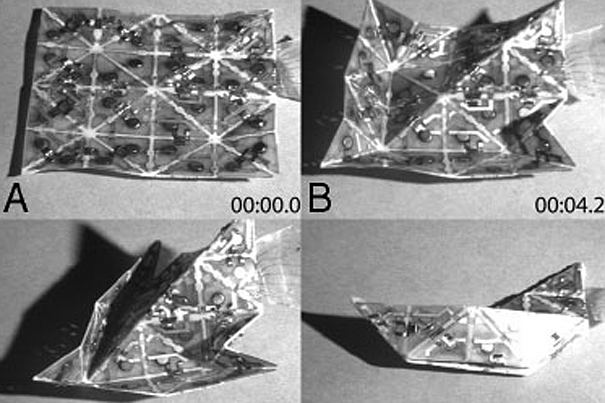MIT, Harvard researchers create programmable self-folding origami sheets

Researchers at Harvard University and the Massachusetts Institute of Technology (M.I.T.) have developed self-folding smart sheets of fiberglass inspired by the ancient art of origami.
The team demonstrated how a single thin sheet composed of interconnected half-millimeter thick and half-inch-wide triangular sections could transform itself into simple forms that resemble their everyday paper equivalents, like a boat and a plane.

These "smart sheets" are essentially origami robots that will make any shape on demand. Robert Wood, an associate professor of electrical engineering at the Harvard School of Engineering and Applied Sciences (SEAS), explains; "The process begins when we first create an algorithm for folding. Similar to a set of instructions in an origami book, we determine, based upon the desired end shapes, where to crease the sheet."
The sheet itself is made up of rigid tiles and elastomer joints and is studded with thin foil actuators (motorized switches) and flexible electronics. The demonstration material contains twenty-five total actuators, divided into five groupings. A shape is produced by triggering the proper actuator groups in sequence. And this is accomplished via a series of stickers that contain the circuitry that prompts the actuators to make the folds, which are then held in placed by magnetic closures.
Scientific American delved into a recently published paper detailing the technology and reports: "Some of the joints have heat-sensitive actuators that bend 180 degrees when warmed by an electric current, folding the sheet over at that joint. Depending on the program used, the sheet will conduct a series of folds to yield the boat or airplane shape in about 15 seconds. The folding-sheet approach is an extension of the field of computational origami, the mathematical study of how flat objects can be folded into complex, three-dimensional structures."
The long-term aim of this technology is to make programmable matter more robust and practical, possibly making everyday objects whose mechanical properties can be programmed, says Wood.
According to Scientific American, Daniela Rus, a professor in the Electrical Engineering and Computer Science department at MIT who is also involved in the research, the computational origami technology could form the basis of three-dimensional display systems—for instance, maps that can reproduce the topography of a given region on demand. "You can imagine making machines that have the ability to give you three-dimensional views of the objects they render," Rus says.
"In the more distant future programmable matter applications might move beyond mere shape mimicry to involve programmable optical, electric or acoustic properties", the article concludes.
The video below shows a programmable sheet that self-folds into a boat- and into a plane-shape: